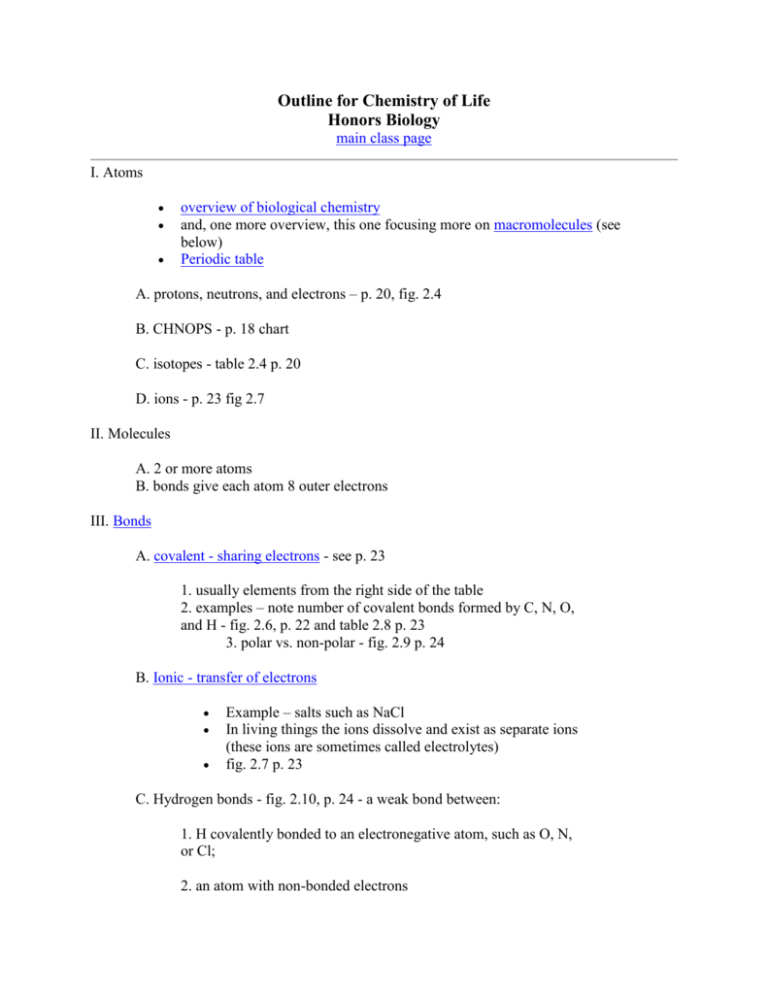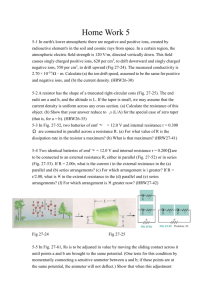Outline for Chemistry of Life
advertisement

Outline for Chemistry of Life Honors Biology main class page I. Atoms overview of biological chemistry and, one more overview, this one focusing more on macromolecules (see below) Periodic table A. protons, neutrons, and electrons – p. 20, fig. 2.4 B. CHNOPS - p. 18 chart C. isotopes - table 2.4 p. 20 D. ions - p. 23 fig 2.7 II. Molecules A. 2 or more atoms B. bonds give each atom 8 outer electrons III. Bonds A. covalent - sharing electrons - see p. 23 1. usually elements from the right side of the table 2. examples – note number of covalent bonds formed by C, N, O, and H - fig. 2.6, p. 22 and table 2.8 p. 23 3. polar vs. non-polar - fig. 2.9 p. 24 B. Ionic - transfer of electrons Example – salts such as NaCl In living things the ions dissolve and exist as separate ions (these ions are sometimes called electrolytes) fig. 2.7 p. 23 C. Hydrogen bonds - fig. 2.10, p. 24 - a weak bond between: 1. H covalently bonded to an electronegative atom, such as O, N, or Cl; 2. an atom with non-bonded electrons 3. example - water molecules are attracted to each other because of hydrogen bonding; the halves of DNA are also held together by this type of bond D. characteristics of water (result from hydrogen bonds and shape of the molecule) - p. 25-26 overview of water properties more on water properties learn more about why water is so important for life another animation 1. high boiling point 2. ice floats - fig. 2.13 3. conducts electricity 4. many items dissolve or form suspensions in water – fig. 2.14 5. cohesion and surface tension – fig. 2.11 6. high specific heat (absorbs a lot of energy to heat up). IV. Acids and bases - p. 27, fig. 2.15 A. definitions and pH scale B. buffers C. importance of acid/base in biology: blood, stomach, etc. V. Chemical vs. physical changes A. chemical reactions - p. 29 V. Organic (bio)molecules (see chapter 3) organic molecules are molecules found in/made by living things - see fig. 3.1 3-D images of biological molecules overview of biological molecules and percentages of each type links to lots of molecular imaging sites molecule of the month - organic molecule illustrations by D. Goodsell A. polymers in general 1. functional groups – p. 35 table 3.2 2. definitions and descriptions 3. most biomolecules are polymers – p. 36 fig. 3.3 4. synthesis and hydrolysis (compare to terms anabolism and catabolism) - fig. 3.3 B. carbohydrates (p. 37 - 39) 1. monomer = sugar (there are several kinds). General formula is CnH2nOn 2. examples of carbohydrates: a. starch b. glycogen c. cellulose d. chitin C. proteins (p. 42 – 45) 1. monomer = amino acid - fig. 3.12 Explore protein structure!! 3-D amino acids animated amino acid 2. polymer = protein with complex 3-D structure - example fig. 3.14 Protopedia Protein Data Bank National Center for Biotechnology Information 3. levels of structure - p. 45, fig. 3.14 3. examples -- D. nucleic acids (p. 46-47) 1. monomer = nucleotide (fig. 3.16) 2. examples - DNA and RNA much more to come later - chap 10 E. Lipids (p. 40-41) overview with examples and pictures microscope images 1. monomer = not always the same (note examples below) 2. fatty acids - glycerol with long hydrocarbon tail (used for energy storage) - fig. 3.8 - link to glycerol to create a fat molecule 3. phospholipids - similar to fatty acids with a charged end; found in membranes. 4. other examples include cholesterol and steroid hormones (fig. 3.9) VI. Enzymes (p. 84-85) A. enzymes are proteins, so they are made of amino acids and have complex three-dimensional structure B. enzymes are biological catalysts. They lower the "activation energy" needed to start a reaction, so they make the reactions go faster. Enzymes control every chemical reaction that takes place inside living things. how do they do this? See fig. 5.14 C. enzymes are specific for particular reactions. Each step in a reaction process has its own enzyme. For example, getting the energy out of sugar (respiration) requires more than 20 separate enzymes. D. Enzymes can be sped up or slowed down by changing conditions such as temperature, pH, and concentration of reactants and products. (inhibitors - see fig. 5.16) back to top








